This was published 8 years ago
Rotterdam, Netherlands: A city to rival Europe's best
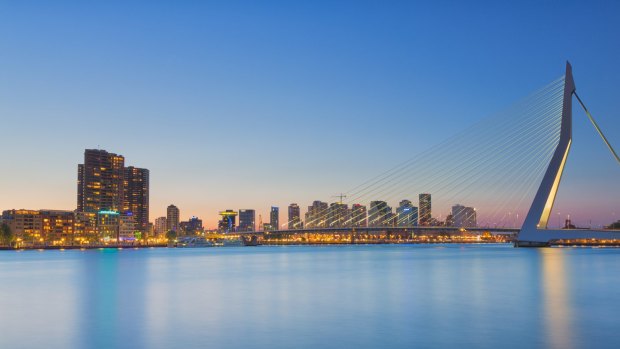
Rotterdam skyline at sunset.Credit: Bas Meelker Photography
Stepping out of Rotterdam Centraal station feels like leaving the Netherlands. Gone are the low-rise medieval town centres, windmill-speckled fields and red brick houses, to be replaced by something that reaches for the future rather than the past.
To the left, the mirrored glass of the Delftse Poort building reflects the fluffy white clouds. Behind, the gleaming metal, distorted chevron roof of the station brings to mind a sportswear logo. It's somewhere between the Speedo emblem and an upturned Nike swoosh.
After nigh-on a decade of construction, the new-look Rotterdam Centraal is more in keeping with a city skyline that has embraced the new, the inventive and often the downright weird.
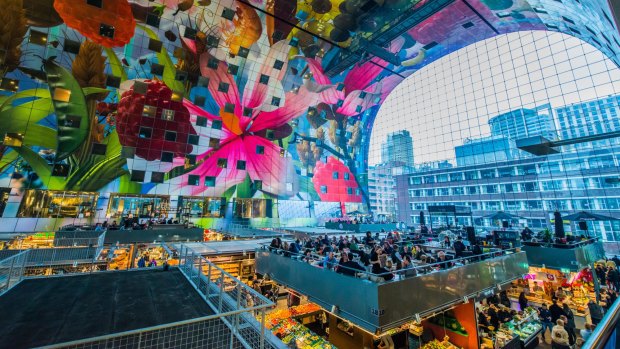
The restaurant in the Market Hall is built over shops.Credit: Alamy
Hester Poortinga, an architect who runs cycling tours for Urban Guides in her spare time, says the point of the roof is very deliberately placed. "It points towards the city," she says.
While Amsterdam has always had its sleeves rolled up to paint, Rotterdam has had them up in the interests of hard work. "The saying has always been that you make it in Rotterdam, then sell it in Amsterdam," Poortinga says.
Unfortunately, being so industrious made it a prime target for the Germans in World War II, and the city was brutally blitzed on May 14th, 1940.
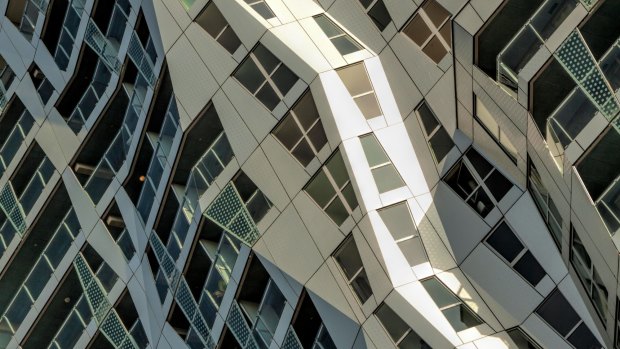
Apartment building Calypso, with its many faceted walls.Credit: Alamy
The merciless bombing campaign left about 85,000 people homeless and almost destroyed the historic city centre. In the 70 years since, Rotterdam has had the choice to rebuild as was or do something new – and it has repeatedly come out in favour of the latter.
The second factor in the city's look is the port – Rotterdam's is the largest in Europe. But the port operations are no longer in the city centre – they've had to move about 40 kilometres away to accommodate huge, modern container ships. This created huge holes to fill and massive spaces to reinvent.
Cycling towards the waterfront, it's telling that Poortinga doesn't think it worth mentioning Calypso, an apartment building with exterior panels alternating in different directions to make the whole edifice look like it's rippling water. It owes a lot to Frank Gehry's Dancing House in Prague, although it is the work of English architect Will Alsop. Anywhere else, this would be a massive talking point. Here, it's merely one of a herd.
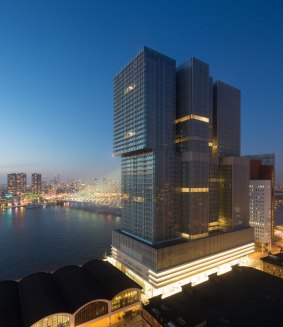
De Rotterdam is the largest multipurpose building in the Netherlands.Credit: Ossip van Duivenbode
Many of the big-name additions to the skyline are clustered on the Wilhelminapier, historically the departure point for European migrants heading for a new life in America. They left from what is now the Cruise Terminal, which has been smartened up considerably. The port trappings that were once alongside it, however, have given way to limelight-seeking towers from the likes of Sir Norman Foster and Renzo Piano.
Piano's is the most interesting, with its leaning glass facade designed to lean at the same angle as the Erasmus Bridge that it stands next to. The bridge, with cables sprouting forth from its elegantly slender, white support pylon, has been nicknamed "The Swan" and gleefully adopted as a symbol of the city.
The newest addition is De Rotterdam, a collection of offices, apartments and restaurants finished in 2013 by local firm OMA. "They wanted to prove it's possible to do high rise without it being narrow," Poortinga says.
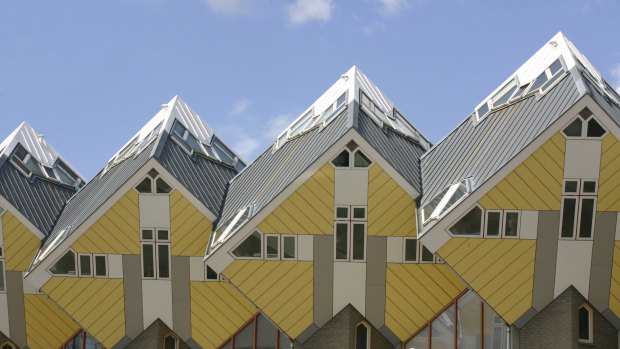
Kubuswoning cube houses created by architect Piet Blom.
Like so many of Rotterdam's buildings, it rewards those taking the time to look at it from different angles. At first glance, it seems like a somewhat top-heavy amorphous blob. But keep going along the waterfront and it becomes obvious that it's three towers, all with blocky bulges pointing in different directions. It's delightfully Tetris-like.
But if it's bizarre blockiness, you're after, the Overblaak development is the place to head to. "In the 1980s, the authorities wanted to connect the Old Harbour to the city centre, and a major road was in the way," Poortinga says. So Piet Blom, who had worked on a couple of smaller projects elsewhere in the country, was called in. And, partially inspired by the Ponte Vecchio in Venice, he set to work making a bridge with houses on it.
Those houses weren't exactly conventional though. The bridge ended up dotted with 38 large cubes, rotated at an angle of 53.5 degrees, seemingly standing on top of poles. It's something of an illusion – one of the cubes has been turned into a museum, where it becomes quickly apparent they're actually three-sided pyramids inside. But you'd struggle to find a home that's more strikingly odd.
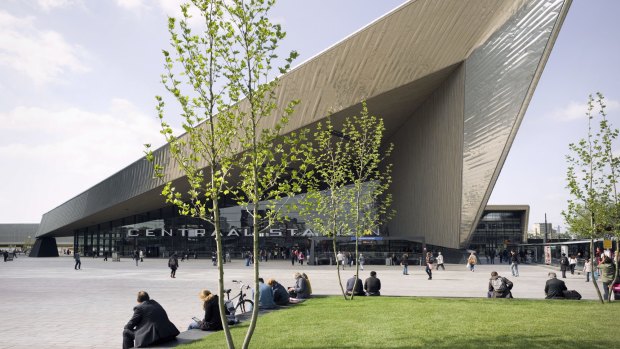
Rotterdam Central Station.Credit: EschCollection
Next to the Cube Houses is another of Blom's creations, The Blaaktower – although it is known as The Pencil because of its stubby body and sharpened tip. And opposite is Rotterdam's new baby. The new Market Hall, which opened in October 2014, has the appearance of a gigantic horseshoe-shaped tube. Some see a sharpener for The Pencil, others an apple-corer, others one of those cylindrical licorice allsorts.
An ultra-clear glass has been used for the facades, while apartments have been built in the curve around the market itself. Each has a window looking over the stalls.
Most remarkable is the defiantly populist interior decoration. Arno Coenen's shamelessly bold, colourful 11,000-square-metre artwork covers the walls and ceiling. It's uncomplicated in the detail – just supersized, somewhat psychedelic images of fruit and animals. The lack of subtlety is rather glorious.
But for all the obvious standouts, perhaps Rotterdam's most admirable piece of new architecture is something that would be very easy to miss. The Hofplein roundabout to the east of Centraal Station isn't exactly a place of unbridled loveliness. Big main roads converge, brutalist buildings surround, and railway lines run behind. But local urban landscaping firm ZUS decided the area shouldn't be a write-off.
The Urban Guides building is inside an ugly old building that has been rebranded as Test Site Rotterdam. Small creative businesses, dance schools and clubs have moved in, and the permanently buzzing Rotterdam Biergarten – all benches and shipping containers – has set up outside. On the other side of the train tracks, some of the city's coolest restaurants have set up in the old railway arches.
To join all of this together, ZUS has built a sprawling, multi-tentacled wooden bridge that goes through buildings and drops down in all the spots that would otherwise require a significant detour.
"What makes it so remarkable," Poortinga says, "is that they didn't have a client. The architects looked for a solution to a problem, then worked out how to fund it rather than waiting to be asked."
The source of that funding becomes clear looking at the thousands of wooden planks forming the sides of the bridge. Each has the name of a company or individual on it – the engraving bought at the cost of €25 each.
And for all the gleaming towers and double-take inducing architectural statements, thousands of crowdfunded planks of wood end up being the defining figurehead of Rotterdam's red-hot rebuild.
BEYOND AMSTERDAM
Three more Dutch cities worth visiting
UTRECHT
Home of the opening stages of 2015's Tour De France, this bike-mad city has a homogenously pretty medieval heart. The 112-metre Domtoren tower is worth the 465-step climb, both for the views and the somewhat trippy bell chamber. On the outskirts, the Rietveld-Schroder House is a brilliant piece of De Stijl architecture, with a mesmerising jigsaw puzzle of sliding and unfolding walls on the first floor. See visit-utrecht.com.
DEN HAAG
Regal buildings built for the Dutch parliament surround the Binnenhof, arguably the country's grandest square. But Den Haag is home to two key (and very different art collections) as well. The Mauritshuis is a high temple of Dutch and Flemish art, with its pinnacle being Vermeer's Girl With A Pearl Earring. The Escher in Het Paleis Museum, on the other hand, is all about M.C. Escher's drawings of mind-bending buildings. See denhaag.com.
MAASTRICHT
The most European-feeling of the Dutch cities, Maastricht has a tremendous cafe scene that combines neatly with heritage sights dating back to eras of Spanish and Roman rule. Exploring the miles of defensive tunnels from Fort Sint Pieter that have been dug out through the centuries is the must-do. See vvvmaastricht.nl.
TRIP NOTES
MORE INFORMATION
GETTING THERE
Etihad flies from Sydney and Melbourne to Amsterdam Schiphol Airport, via Abu Dhabi, see Etihad.com. Direct trains to Rotterdam from the airport take under half an hour.
STAYING THERE
The nhow, a deliberately hip sub-branch of the NH hotel chain, is inside De Rotterdam, rooms from $175, see nhow-rotterdam.com. The Stayokay hostel is inside one of Piet Blom's cube houses, with dorm beds from $28, see stayokay.com.
SEE + DO
The Urban Guides modern architecture cycling tour costs $270 for a group of up to 15, see urbanguides.nl. Entry to the Cube House Museum is $5, see kubuswoning.nl.
The writer travelled at his own expense.
Sign up for the Traveller Deals newsletter
Get exclusive travel deals delivered straight to your inbox. Sign up now.